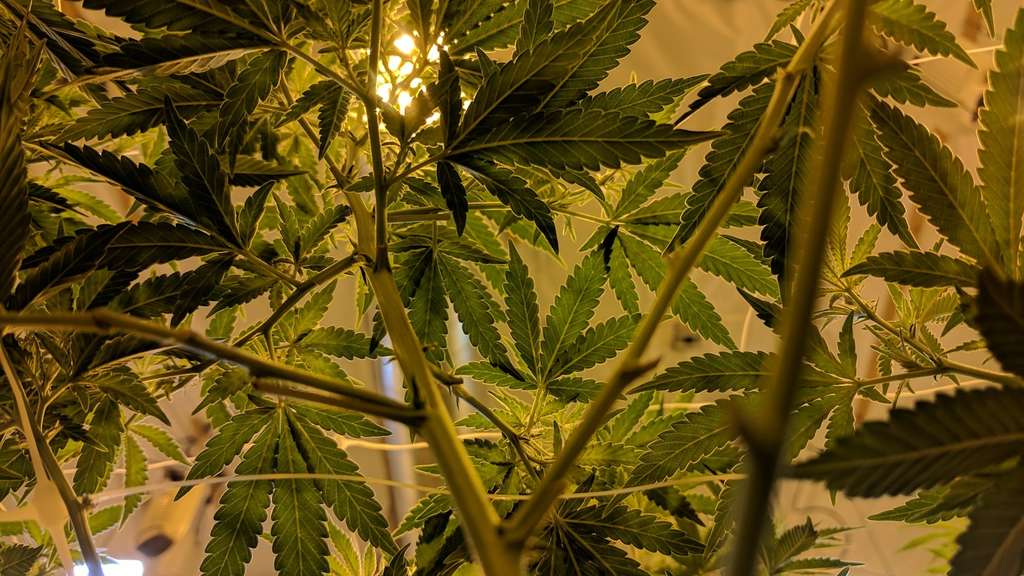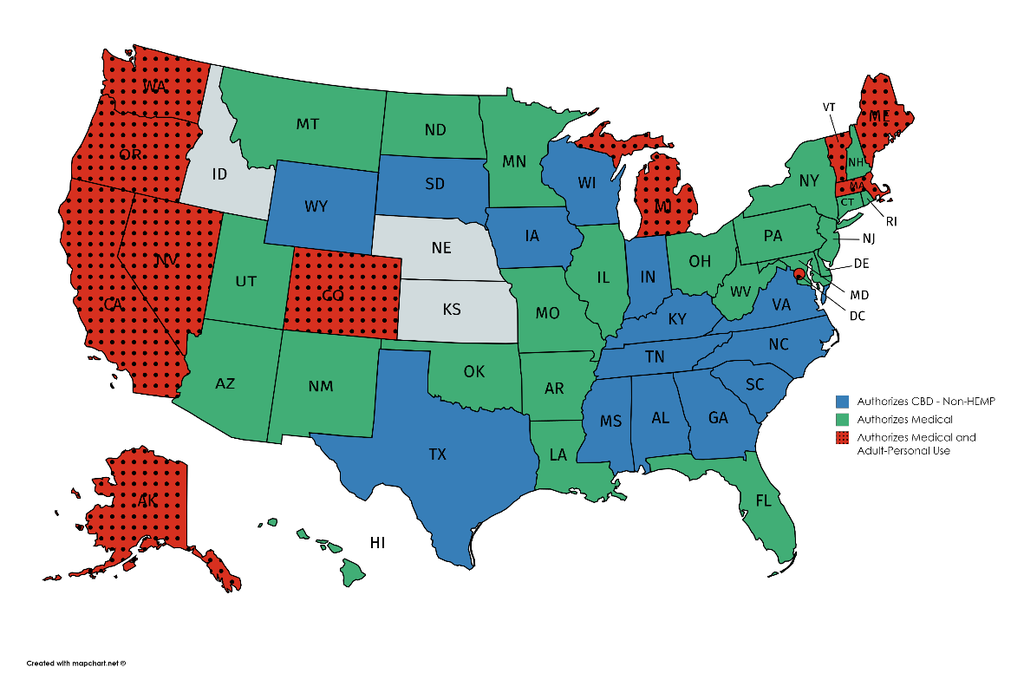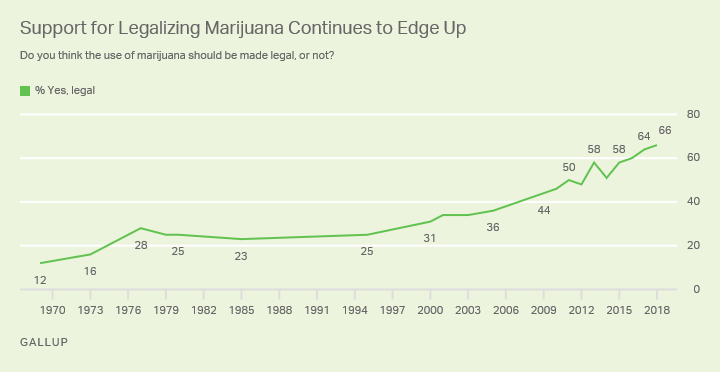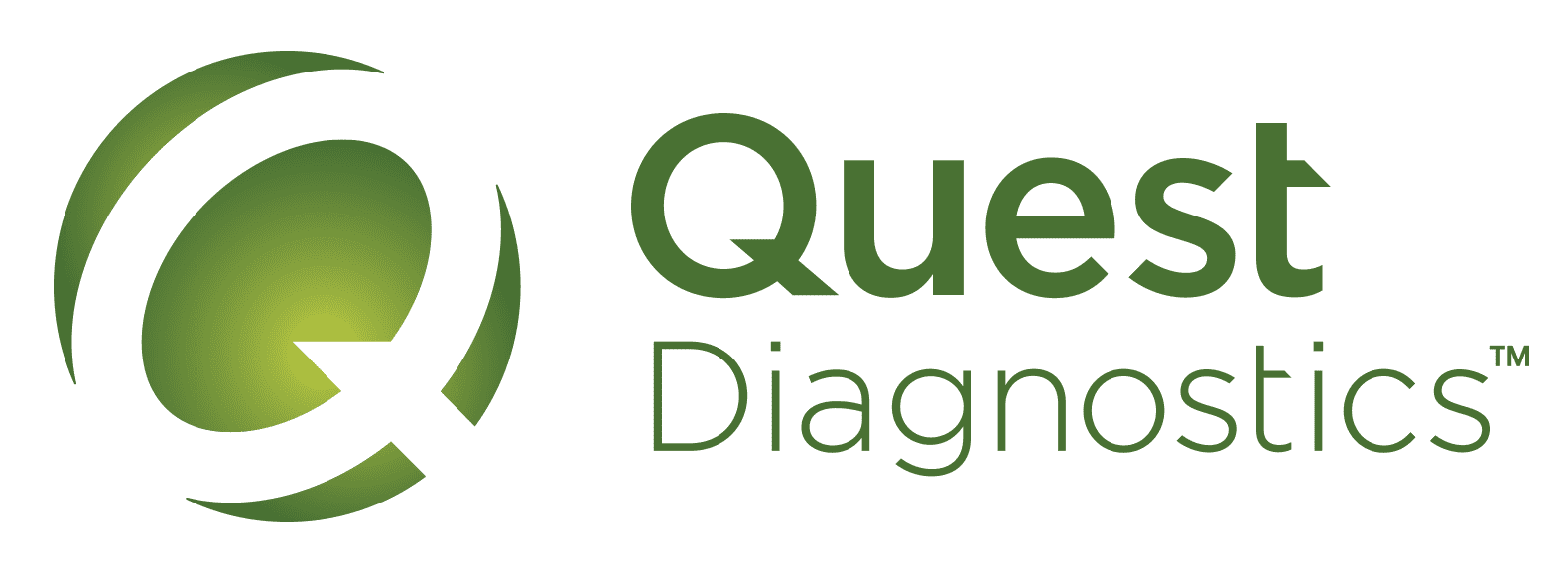Since marijuana use is now legal in more than half the country, it must be safe, right? Why can't I use it in the workplace? Why should employers still have a policy that doesn't allow marijuana use? Why are companies still testing for marijuana?
Why, why, why!
As states continue to legalize marijuana and cannabidiol (CBD) for both medical and personal use, both employees and employers are raising more questions. Many of these questions have no easy answers. Employers must take time to examine the rules that apply specifically to their operations and their company's workplace culture and philosophy.
Background
New public opinion polls show that anywhere from 61%[1] to 66%[2] of Americans support legalization of marijuana for personal use. It's a trend that continues to "grow."
Another recent poll found that 93% of American voters support medical use if a doctor recommends it.[3]
The possession or use of marijuana remains illegal under federal law.[4] But, in all but three states marijuana or cannabidiol have been legalized for medical or personal use. Confused? The federal government has added to the confusion by passing the 2018 Farm Bill[5] which removed hemp from the Controlled Substances Act (CSA) and approving the medical use of a cannabis-derivative CBD product called Epidiolex.[6] These rapid developments have led to mass confusion with many people wrongly thinking that CBD (or marijuana) is legal from any source and in any form. It's not!
How, then, should employers address the questions of safety, use of marijuana at work, and policy or testing issues? Let's look at these issues one at a time.
Is it safe?
The answer to this question depends on who you believe. Studies and commentaries are answering the issue both ways.[7] There is no debate that, excluding tobacco and alcohol, marijuana is the most frequently used controlled substance in the United States.[8]
A new report from Quest Diagnostics found that more people are testing positive for marijuana in United States workplace drug tests. A review of more than 10 million drug test results showed that positive marijuana rates were up 8% in 2017, an increase of 14% since 2014.[9]
It was reported that states that recently legalized recreational marijuana saw the most significant increase in workforce marijuana use: 43% of Nevada's workforce tested positive, 14% of Massachusetts' workforce tested positive, and 11% of California's workforce tested positive for marijuana use.
People who work in safety-sensitive jobs, like pilots, bus drivers, and other federal workers, also had an increased marijuana positivity rate on drug tests.[10]
There is no question that employers must provide employees with a safe place to work.[11] Employers must recognize that drug and alcohol use can impact workplace safety. One recent survey showed that . . .
- Seven in 10 illicit drug users have used at work.[12]
- More than 30% of the respondents used illicit drugs with co-workers.[13]
- 28% of illicit drug users get high on the way to work; 22% get high at lunchtime.[14]
The latest available statistics from the Bureau of Labor Statistics shows that overdose deaths while working increased 25% in 2017, the fifth successive year of such increases.[15]
But, say for those in favor of marijuana legalization and opposed to drug testing, we don’t test for the impairing metabolite of cannabis.

Without getting too deep into the toxicological weeds, it has been reported that "[t]he cannabis plant contains more than 421 chemicals of which 61 are cannabinoids."[16] The same study found that "[a]fter smoking a cigarette containing 16-34 mg of Δ9-THC, THCCOOH is detectable in plasma for 2-7 days. A clinical study carried out among 52 volunteers showed that THC-COOH was detectable in serum from 3.5 to 74.3 hours. Initial concentration was between 14-49 ng/mL,[17] considerably less than the THCCOOH detection time of 25 days in a single chronic user."[18]
What does all this mean and what is Δ9-THC or THCCOOH – and why should I care?
Δ9-THC or delta-9-tetrahydrocannabinol (THC) and THC-COOH (carboxy-THC) are two of the principal "chemicals" found in cannabis. Carboxy-THC is a metabolite of Δ9-THC. The other principal metabolite of Δ9-THC is 11-hydroxy Δ9_ Tetra hydrocannabinol (11- OH-THC or hydroxy-THC.).
THC and hydroxy-THC are psychoactive, carboxy-THC is not.[19] THC and hydroxy-THC are only detectable in the body for up to 1.3 days for infrequent users and 5 to 13 days for frequent users depending on the strength of the dose and several other factors.[20]
Applying this information to the workplace, it cannot be determined if a positive result for "marijuana" shows use just before work, while working or days ago. Employers do know that they must keep the workplace safe. Unless there is some rule prohibiting employment action, employers should take reasonable steps to protect their workplace.[21]
Why can't I use marijuana at work?
There is a long list of practical reasons why marijuana use is not permitted while at work. Similar to alcohol use, being "intoxicated" at work does not positively contribute to company goals and objectives. Beyond all of the practical purposes, there is no way to tell from a drug test for marijuana whether the result shows long-term use or recent use.
Many, if not all, of the state laws authorizing medical or personal use of marijuana expressly prohibit use at work.[22] That said, the data shows that common sense being ignored, as demonstrated from surveys of admitted illicit marijuana users, that they have used marijuana on the way to work, during lunch breaks, and at other times during the work period.
Why should employers continue to have policies that prohibit the use of marijuana, and why continue testing for it?
Employers across the country are wondering if they should continue testing for marijuana. As noted earlier, all but three states have approved the legalization of cannabis use (medical or personal use of marijuana or CBD).
Safety must be an employer's first consideration in making this decision. Sure, employers are having a tough time finding qualified workers. But with such a significant number of workers testing positive for marijuana use and the admission of illicit drug users discussed earlier in this article can employers comfortably ignore the impact allowing such use at work could have?
The old saying "you hired the problem" has never been more on point. An old blind two-part study of postal workers in the early days of drug testing was conducted.
As part of a blind longitudinal study, 5,465 job applicants were tested for the use of illicit drugs, and the relationships between these drug-test results and absenteeism, turnover, injuries, and accidents on the job were evaluated. The results of the tests were not disclosed to the employer or applicants.
After an average of 1.3 years of employment, employees who had tested positive for illicit drugs showed the following.
In part one:
- Workers who smoke marijuana are more likely to experience increased absences, tardiness, accidents, workers' compensation claims and job turnover.
- Workers who test positive for marijuana use have 55% more industrial accidents, 85% more injuries and a 75% increase in absenteeism compared to non-smokers.
In part two:
- Workers had an absenteeism rate of 59.3% higher than employees who had tested;
- They had a 47% higher rate of involuntary turnover than employees who had tested negative.[23]
Marijuana users may say that their use doesn't affect them at work. Can they accurately judge this? A 1985 study on the "hangover effects" of marijuana might cast doubts.
Ten experienced licensed private pilots were trained for eight hours in a flight simulator to establish a baseline for landing an airplane. Then they each smoked a cigarette containing 19 mg of THC provided by the federal government. Twenty-four hours later "their mean performance on the flight task showed trends toward impairment on all variables, with significant impairment in number and size of aileron changes, size of elevator changes, distance off center on landing, and vertical and lateral deviation on approach to landing. Despite these deficits, the pilots reported no awareness of impaired performance.[24] Employers are also often timed required to still screen for marijuana use such as in Federal/DOT testing programs, federal grant requirements, mandatory state law, customer/contract requirements, etc.
Conclusion
If pre-employment marijuana screening is to be segmented or discontinued across the board, employers must seriously direct their attention to post-employment screening – specifically reasonable suspicion testing. A positive test result cannot show whether the employee last used last month, last week, or within the last hour. But employers could still be liable for the actions of an employee incapable of safely performing assigned tasks due to the impact marijuana has on their ability to perform.[25]
While employers across the country work to strike a balance in their workplace, it's critical to understand the rules that apply, the potential risks that can arise, the pros and cons of testing or not, the importance of training supervisors to enforce a safe and drug-free workplace, and to educate everyone on the impacts of drug use.
As it Stands Today

- 33 states and Washington, DC authorize the medical use of marijuana;
- 10 States allow Medical and Adult-Personal Use
- 14 states allow the medical use of CBD (Non-Hemp)
[1] https://hightimes.com/news/national-poll-finds-61-percent-americans-favor-legalizing-marijuana/
[2] https://news.gallup.com/poll/243908/two-three-americans-support-legalizing-marijuana.aspx?version=print
[3] https://poll.qu.edu/images/polling/us/us03062019_uenh42.pdf/
[4] 21 U.S.C. §812, Sch. I, (c)(10).
[5] The Agricultural Improvement Act of 2018 (H.R. 2), signed into law December 20, 2018.
[6] FDA approved the new CBD drug in June 2018 and in September 2018 the DEA placed the drug on Schedule V. https://www.dea.gov/press-releases/2018/09/27/fda-approved-drug-epidiolex-placed-schedule-v-controlled-substance-act
[7] For those arguing that it is safe to use marijuana see for example https://www.safeaccessnow.org/cannabis_safety. But see, https://injepijournal.biomedcentral.com/articles/10.1186/s40621-017-0105-z
[8] https://www.nsc.org/work-safety/safety-topics/drugs-at-work/substances;
[9] https://www.questdiagnostics.com/home/physicians/health-trends/drug-testing.html; https://www.businessinsider.my/workforce-marijuana-use-on-the-rise-in-safety-sensitive-jobs-2019-1/;
[10] https://www.questdiagnostics.com/home/physicians/health-trends/drug-testing.html
[11] The employer’s obligation to provide a safe workplace stems from the “General Duty Claus” under the Occupational Safety and Health Act of 1970, which at Section 5 states in part, "(a) Each employer -- (1) shall furnish to each of his employees . . . a place of employment . . . free from recognized hazards that are causing or are likely to cause death or serious physical harm to his employees." (29 U.S.C. 654)
[12] https://www.detox.com/explore/drugged-out-daily-grind/
[13] https://www.detox.com/explore/drugged-out-daily-grind/
[14] https://www.detox.com/explore/drugged-out-daily-grind/
[15] www.bls.gov/iif/oshcfoi1.htm
[16] Mechoulam R. Plant cannabinoids: a neglected pharmacological treasure trove. Br J Pharmacol 2005; 146: 913-915; Appendino G, Chianese G and TaglialatelaScafati O. Cannabinoids: occurrence and medicinal chemistry. Curr Med Chem 2011; 18: 1085-1099; Iran J Psychiatry 2012; 7:4: 149-156. See also Z. Atakan, Cannabis, a complex plant: different compounds and different effects on individuals, Ther Adv Psychopharmacol (2012) 2(6) 241–254, where the author points out that cannabis has been used by mankind for at least 6,000 years.
[17] Keep in mind that in workplace testing 15 ng/mL is the confirmation cutoff rate. 49 CFR part 40.87.
[18] Priyamvada Sharma, PhD, Pratima Murthy, M.M., Srinivas Bharath, Iran J Psychiatry 2012; 7:4: 149-156.
[19] Priyamvada Sharma, PhD, Pratima Murthy, M.M., Srinivas Bharath, Iran J Psychiatry 2012; 7:4: 149-156.
[20] Smith-Kielland A, Skuterud B, Morland J. Urinary excretion of 11-nor-9-carboxy-delta9- tetrahydrocannabinol and cannabinoids in frequent and infrequent drug users. J Anal Toxicol 1999; 23: 323-332.
[21] Please note that as of this writing the New York City Council has passed an Ordinance that would prohibit preemployment testing of marijuana. The Ordinance does carve out exception for safety positions and tests required by federal or other governmental rules. Washington, D.C. limits preemployment marijuana testing to candidates who have been given an offer.
[22] For the Arizona Medical Marijuana Act states, "36-2814. Acts not required; acts not prohibited, * * *
Nothing in this chapter requires: * * * An employer to allow the ingestion of marijuana in any workplace . . .
[23] Normand J, Salyards SD, Mahoney JJ, An evaluation of preemployment drug testing, Appl Psychol. (1990 Dec;75(6):629-39.), second part to Zwerling C, Ryan J, Orav EJ., The efficacy of preemployment drug screening for marijuana and cocaine in predicting employment outcome, JAMA. (1990 Nov 28;264(20):2639-43.)
[24] Yesavage et al, Carry-Over Effects of Marijuana Intoxication on Aircraft Pilot Performance: A Preliminary Report, Am J Psychiatry 142:1325-1329, 1985) (later confirmed).
[25] This could be costly. Marijuana may pose a litigation risk to employers. It has been suggested that the cost of defending an employment practices liability suit is between $69,000 and $107,000-not including any awards. Millman, George. "Medical marijuana poses litigation risks to employers." Wall Street Journal, August 15, 2013.





